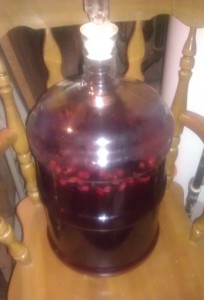Three weeks of primary fermentation was enough to get my mixed berry mead or melomel down to a gravity of 1.000 from a starting gravity of 1.096. After I checked the reading, it was clear that the time for conditioning was upon us.
If you remember from my mead making day, ten pounds of berries and stone fruits went into the bucket along with the honey, water, and yeast. Because berry seeds are hard to separate from the finished mead (you can do it but you have to rack the mead multiple times), I used a fine mesh bad to hold the berries and hopefully to keep the seeds from becoming a clarifying issue in the future.
To rack the mead to another carboy, I had to remove the bag full of the fruit from the bucket first, slowly so that it would drain out. I didn’t want to throw out mead with the bag as they say.
From first impressions, the bag worked like a charm. The number of seeds racked into the secondary vessel was minimal if any. I fully recommend using a bag like this one to separate the unwanted stuff from your mead.
I had 4 ounces of American oak chips left over from my last mead adventure in my ingredients bin. To prepare them for the conditioning phase, they were steamed on my stovetop for 15 minutes.
The plan is to let the oak get acquainted with the mead for a month. The oak should marry well with the red and purple berry flavors. The 71-B yeast does make mature wines quickly, which isexactly what the description said it would do. The quick taste from the hydrometer sample had no hot flavors.
Once the oak conditioning is over, it will get racked to another vessel to let it clarify. We see if that will be the only time I need to rack it or not. I could always use bentonite to clear it up quickly but this time I didn’t want to add anything to it.
In a month, I should have a drinkable mead and should be just a few weeks away from bottling it.


Leave a Reply